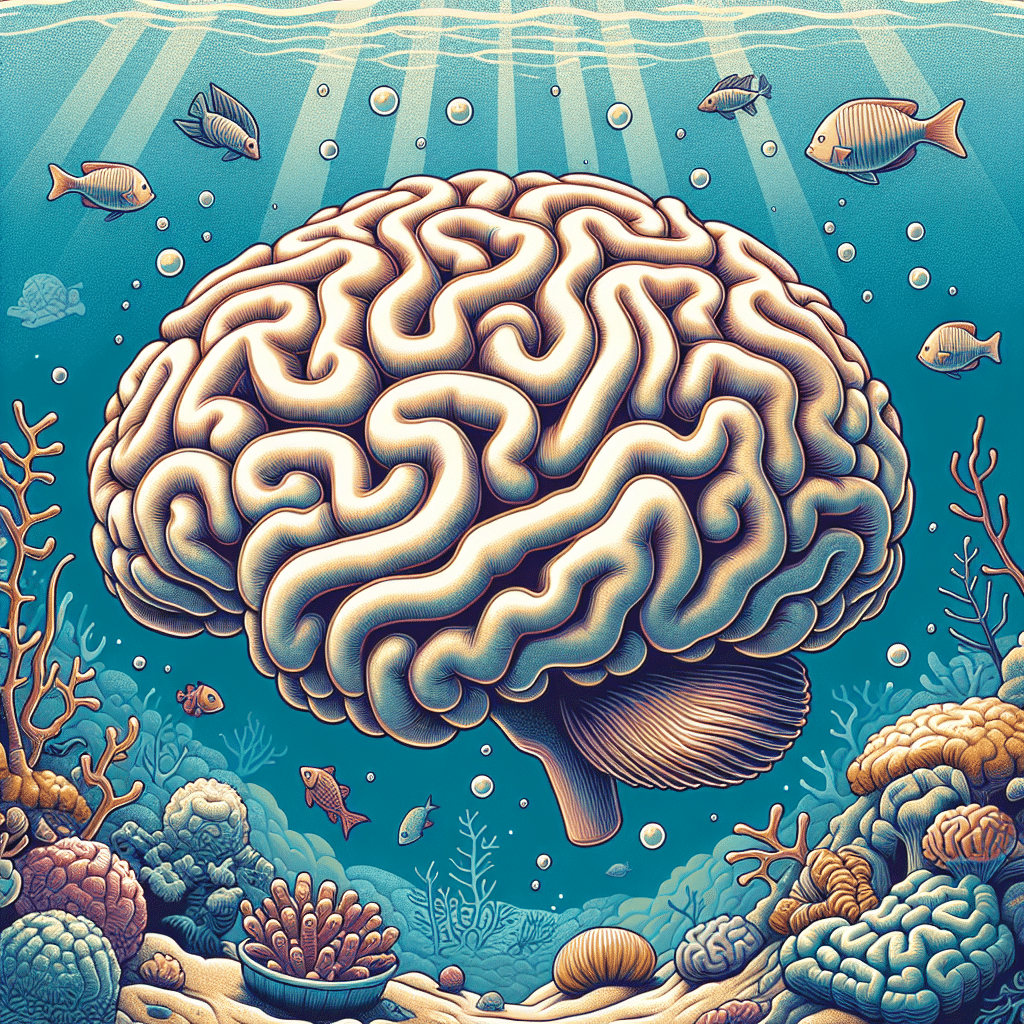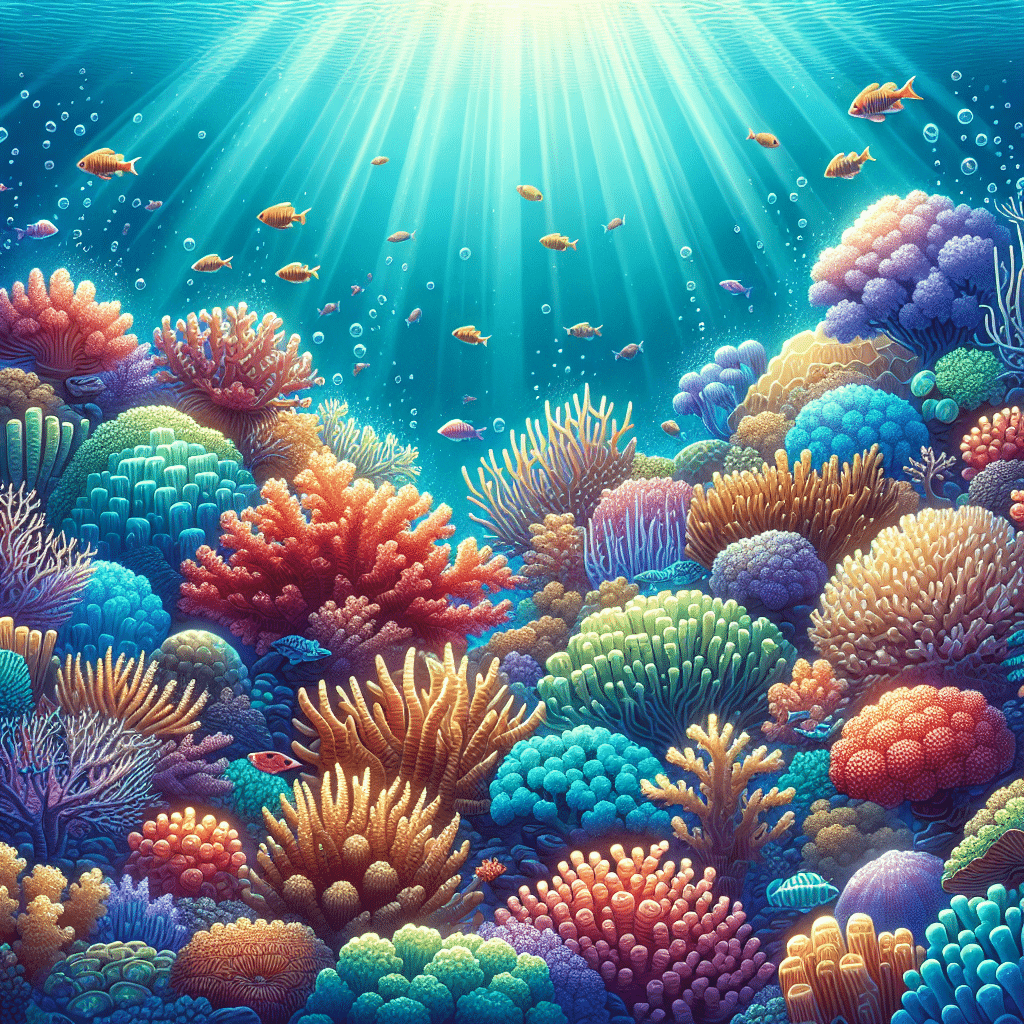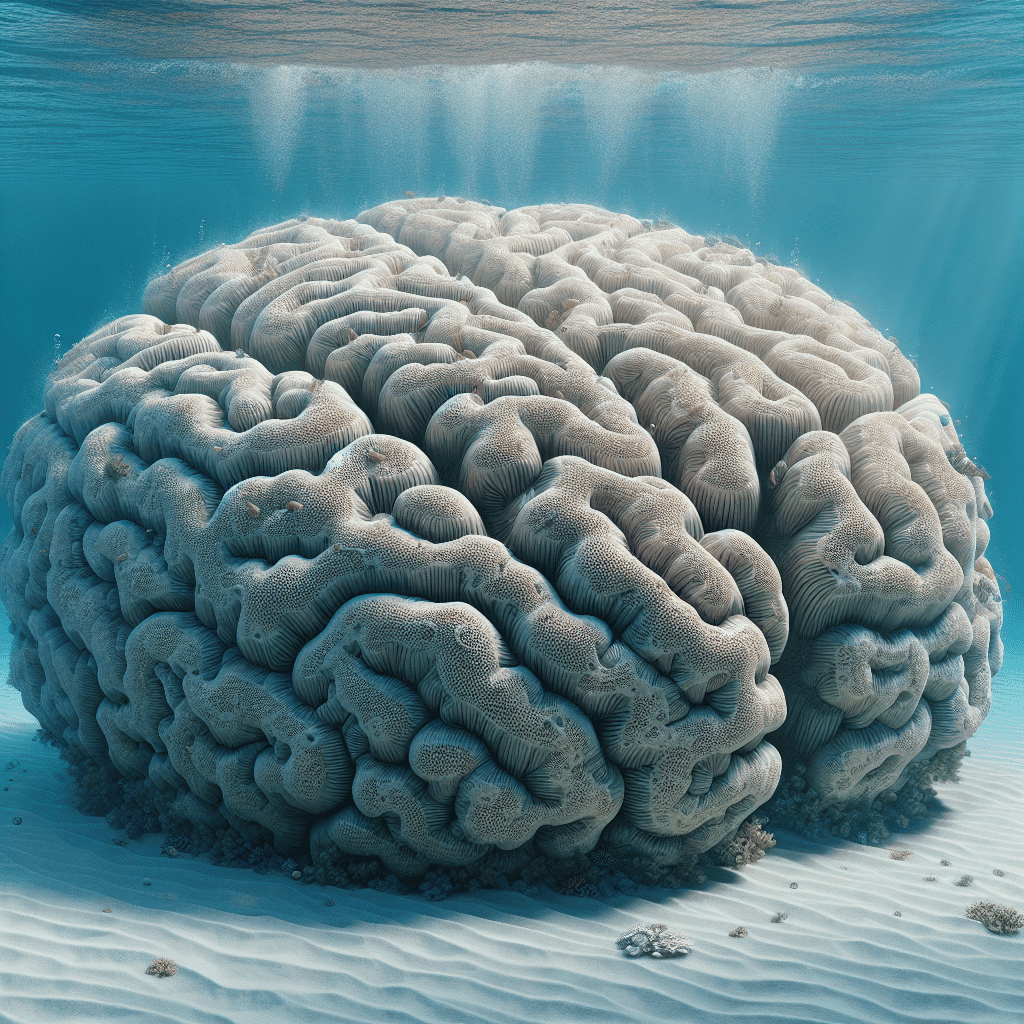Understanding Brain Corals
Brain corals are fascinating creatures that play a significant role in reef ecosystems. I find their unique structure and longevity quite impressive.
The Role of Brain Corals
Brain corals, classified as massive growth type corals, can grow up to six feet tall and live for an astonishing 900 years. They are commonly found in the Caribbean, Atlantic, and Pacific Oceans. Their slow growth contributes to the development of strong, durable structures that serve as the foundation of coral reefs. These corals absorb up to 97 percent of wave energy during storm events, which helps protect marine life and coastal areas from erosion and damage.
Additionally, brain corals exhibit a remarkable form of tissue integration called Meandroid, where polyps are highly interconnected. This integration allows for seamless communication within the colony, facilitating the transfer of crucial molecules like nutrients, hormones, and oxygen.
Growth and Lifespan
The growth rate of brain corals is relatively slow, which is common for massive growth corals. Despite their slow growth, their ability to live for centuries makes them an integral part of the reef ecosystem. This long lifespan not only contributes to the stability of the reef structure but also provides a habitat for various marine species.
The health of brain corals can be affected by environmental factors and diseases. Vulnerabilities arise from their tissue integration; if one polyp becomes sick, diseases such as black band disease or white plague can spread rapidly throughout the colony. Understanding these factors is essential for any hobbyist looking to maintain their own reef tank with brain corals.
If you’re interested in learning more about different types of corals, check out our articles on brain coral, black coral, and torch coral.
Communication Among Brain Corals
Brain corals are fascinating organisms, and their ability to communicate through tissue integration is one of the things that makes them stand out.
Tissue Integration
In brain corals, the polyps are closely associated with each other, exhibiting what is known as Meandroid tissue integration. This setup allows for a high degree of interaction among the polyps. It means they can transfer important molecules like nutrients, hormones, and oxygen, which aids in their communication within the colony. This unique feature helps the corals maintain a healthy and cohesive structure, which can be critical for their survival. Brain corals can grow up to six feet tall and live for up to 900 years, making their communication system an essential aspect of their longevity (NOAA).
| Feature | Description |
|---|---|
| Growth Height | Up to 6 feet |
| Lifespan | Up to 900 years |
| Communication Method | Tissue integration (Meandroid) |
Vulnerabilities to Diseases
While the tissue integration in brain corals facilitates communication, it can also make them vulnerable to diseases. If one polyp becomes infected, diseases such as black band disease, white plague, and thermal bleaching can spread quickly throughout the entire colony (NOAA). This interconnectedness means that maintaining good health in one polyp is critical for the overall health of the colony.
To protect my own reef tank, I make sure to monitor the health of my corals closely. Understanding the vulnerabilities of brain corals can help me take proactive measures against potential diseases. If you’re looking for more coral types to consider, check out brain coral and explore others like bubble coral and mushroom coral.
Importance in Coral Reefs
Massive Growth Type
Open brain corals, like other brain corals, are classified as massive growth type corals. They grow slowly but build strong, dense structures that serve as the foundation of coral reefs. This solid structure is essential for supporting various marine life and maintaining the overall health of the reef ecosystem. I find it fascinating how these corals can grow over many years, contributing to the intricate architecture of reefs.
| Coral Type | Growth Rate | Structure Type |
|---|---|---|
| Open Brain Coral | Slow | Massive |
| Other Brain Corals | Slow | Massive |
Protection and Energy Absorption
One of the most impressive features of open brain corals is their ability to protect marine life and coastlines. They absorb up to 97 percent of wave energy during storm events, which helps to prevent erosion and damage to the shorelines. This protective quality not only benefits the coral itself but also the myriad of organisms that call the reef home. By acting as natural barriers, these corals play a critical role in maintaining the ecological balance of their environments. Their presence helps shield other marine species from the harsh forces of nature, allowing for a diverse and thriving ecosystem.
For more information on different types of corals, check out our articles on brain coral and other corals like mushroom coral or staghorn coral. Understanding these relationships in the reef ecosystem can enhance our appreciation of the delicate balance of marine life.
Chimerism in Coral Reefs
Chimerism in coral reefs is a fascinating process that occurs when two tiny coral babies fuse together during their early development stages. This unique phenomenon creates a colony that contains two different genotypes, effectively doubling the size of the recruit. This can potentially accelerate growth and make the colony more resilient to threats such as competition and predation. The increased chance of survival makes chimerism a relevant topic in restoration research (SECORE).
Fusion of Coral Babies
The fusion of coral babies is not just a quirky occurrence; it plays a significant role in the dynamics of coral populations. By combining genetic material from two separate parents, chimeric corals can exhibit traits that enhance their overall fitness. This can lead to a more robust colony that is better equipped to handle environmental stressors. The resulting chimera is larger, which can also help it compete more effectively for resources in its habitat.
Advantages and Research
There are several advantages to chimerism in coral reefs. First, it provides enhanced fertilization potential. When two genotypes are combined within a single chimeric colony, it can facilitate outbreeding, increasing genetic diversity. This aspect has garnered attention as a promising tool for coral reef restoration strategies (SECORE).
Research is ongoing to understand how chimeras can act as an evolutionary rescue mechanism. They may carry genetic traits that could be beneficial in adapting to future environmental changes, even if those traits aren’t currently advantageous. Scientists, like Sandra Mendoza-Quiroz at the Coralium Lab (UNAM) in Mexico, are actively studying these processes to uncover their potential benefits for coral resilience and restoration efforts (SECORE).
By understanding chimerism and its implications, I can appreciate the complexities of coral biology and the innovative strategies being explored to protect and restore our valuable coral reefs. If you’re interested in learning more about corals, check out our article on brain coral or explore other coral types like mushroom coral and acropora.
Selective Breeding for Coral Resilience
Genetic Adaptations
When it comes to keeping my reef tank thriving, I’ve learned that selective breeding can really help corals adapt to changing conditions, especially with rising ocean temperatures. For instance, studies have shown that crossing Indian Ocean mothers with Persian Gulf fathers leads to an impressive 84% increase in survival rates at high temperatures. This genetic adaptation makes the offspring as resilient as purebred Persian Gulf corals (The Conversation).
Most Persian Gulf fathers tend to pass on crucial gene variants that help their offspring withstand heat stress. On the other hand, Indian Ocean fathers usually produce babies that are less capable of coping with heat. This information is essential for anyone interested in nurturing strong and resilient corals in their tanks.
| Coral Parentage | Survival Rate at High Temperatures |
|---|---|
| Indian Ocean Mothers x Persian Gulf Fathers | 84% |
| Persian Gulf Purebred | Comparable Resilience |
Potential Benefits and Limitations
While selective breeding can significantly boost coral resilience to warmer waters, it’s important to remember that it’s not a magic fix. I realize that this approach cannot replace the urgent need to cut down on greenhouse gas emissions, which is crucial for limiting ocean temperature increases. Breeding might speed up the natural selection process, especially since some coral populations already have genetic variations that allow them to thrive in hotter oceans.
In my experience as a reef tank hobbyist, focusing on selective breeding is just one piece of the puzzle. Here’s a quick overview of potential benefits and limitations:
| Benefits | Limitations |
|---|---|
| Increased survival rates at high temperatures | Not a substitute for reducing greenhouse emissions |
| Enhanced heat tolerance through genetic variants | May not address other environmental stressors |
| Accelerated natural selection process | Requires careful management and monitoring |
By understanding these factors, I can make more informed decisions about the corals I choose for my tank and contribute positively to their resilience. For more information on caring for different coral types, check out our articles on brain coral and mushroom coral.
Conservation Efforts in Florida
Florida’s Coral Reef Diversity
Florida’s Coral Reef is a vibrant underwater ecosystem that supports a diverse range of marine life. This includes various coral species like elkhorn corals, sea fans, and brain corals. These corals create living community centers for numerous species, such as sea turtles, nurse sharks, and over 500 different species of reef fish (Florida’s Coral Reef Conservation).
The Southeast Florida Coral Reef Ecosystem Conservation Area, managed by the Florida Department of Environmental Protection’s Coral Reef Conservation Program, spans approximately 105 miles. It covers a rich array of stony and soft corals, macroalgae, and fish species, providing essential habitats for marine biodiversity (Florida’s Coral Reef Conservation).
| Coral Species | Notable Characteristics |
|---|---|
| Elkhorn Coral | Forms large, branching structures |
| Staghorn Coral | Has a unique antler-like shape |
| Brain Coral | Resembles a brain with its ridges and valleys |
Restoration Projects
To combat the declining health of coral reefs, Florida has initiated several restoration projects. The Coral Reef Conservation Program executed its first management-led restoration project to address direct impacts caused by vessel groundings offshore Fort Lauderdale. This project involved both physical and biological restoration stages to help rehabilitate damaged areas (Florida’s Coral Reef Conservation).
Additionally, the John Pennekamp Coral Reef State Park in Key Largo plays a significant role in conservation efforts. It was established to protect and preserve a portion of Florida’s Coral Reef while offering guided glass-bottom boat tours, snorkeling, and SCUBA diving experiences for visitors to explore the vibrant marine life.
Dry Tortugas National Park also contributes to conservation, hosting about 30 species of corals, including elkhorn, staghorn, and pillar coral. This park provides a unique habitat for various marine life, including parrot fish, angelfish, and triggerfish.
By participating in these conservation efforts, I can help ensure a healthier future for these beautiful ecosystems. If you’re interested in learning more about different coral species, check out our articles on brain coral, black coral, and mushroom coral.
Coral Restoration in the Florida Keys
The coral restoration project in the Florida Keys is an exciting initiative aimed at revitalizing the coral reefs that have faced significant challenges. I find it fascinating how structured the process is, involving multiple phases and collaborative efforts to enhance the health of these underwater ecosystems.
Project Phases
The restoration effort is divided into key phases, each with specific goals and strategies.
Phase 1
- Focuses on outplanting a variety of coral species, including star, brain, pillar, and staghorn corals.
- Aims to increase coral cover across seven sites from 2% to 15% over the first 7 to 10 years.
- Includes the outplanting of sea urchins and Caribbean king crabs to control algae overgrowth that can harm coral reefs.
Phase 2
- Continues the outplanting of elkhorn, star, brain, pillar, and staghorn corals, along with other small stony corals like finger coral.
- Aims to further increase diversity, function, and resiliency of the reef, targeting an average coral cover of 25%.
The project aims to utilize nearly 500,000 stony coral colonies for these restoration efforts, emphasizing the importance of collaboration with multiple partners (NOAA).
Collaborative Efforts
Collaboration is a key aspect of the restoration project. Various stakeholders, including professional and volunteer divers, work together as “gardeners” on the reefs. Their tasks include:
- Removing marine debris and nuisance species.
- Addressing damaged corals and reattaching any that have become disconnected during the restoration process.
By combining the expertise of professionals with the enthusiasm of volunteers, the project aims to create a more resilient reef ecosystem. This teamwork is essential, not just for restoring coral health, but also for ensuring that the reefs can thrive in the future.
As I learn more about these efforts, I can’t help but appreciate the complexity of coral ecosystems and the importance of maintaining their health, especially for those of us who enjoy keeping corals in our reef tanks.
Involvement in Restoration Activities
In my journey as a fish tank and reef tank hobbyist, I’ve learned that participating in coral restoration activities can be incredibly rewarding. Not only do I get to contribute to the health of our oceans, but I also gain valuable insights into marine life along the way.
Workforce Participation
The coral restoration project in the Florida Keys is a fantastic example of how both professional and volunteer divers come together as “gardeners” on the reefs. This workforce plays a crucial role in removing marine debris, tackling nuisance species, and addressing damaged corals. By reattaching disconnected corals, they help to restore the natural balance of the reef ecosystem (NOAA).
| Role | Responsibilities |
|---|---|
| Professional Divers | Oversee restoration efforts, provide training to volunteers |
| Volunteer Divers | Assist in coral reattachment, clean-up, and monitoring |
| Community Members | Participate in awareness campaigns and fundraising |
Reef Gardening Techniques
Reef gardening is a method I find fascinating and effective for coral restoration. It involves nurturing and cultivating coral in a controlled environment before transplanting them back to the reef. Here are some techniques used in reef gardening:
Coral Fragmentation: This technique involves cutting healthy coral into smaller fragments, which can then be grown in a nursery until they are large enough to be reattached to the reef.
Transplanting: Once the coral fragments have grown sufficiently, they are carefully transplanted onto damaged areas of the reef, ensuring they have the best chance of survival.
Monitoring: Regular check-ups on transplanted corals are essential. This involves observing growth rates and health, as well as removing any competing species that might hinder their development.
Nutrient Management: Ensuring that the water quality is optimal for coral growth is crucial. This might involve testing water parameters and making adjustments as needed.
By employing these techniques, I not only help restore damaged reefs but also gain a deeper appreciation for the intricate world of coral ecosystems. If you’re interested in learning more about caring for different types of corals, check out our articles on various coral species like brain coral, torch coral, and mushroom coral. Each coral type has its unique requirements and contributes to the overall health of the reef.



